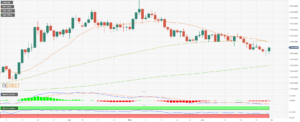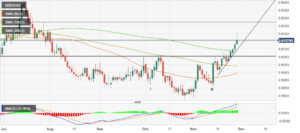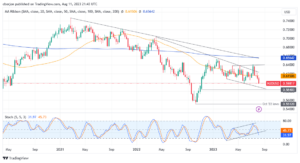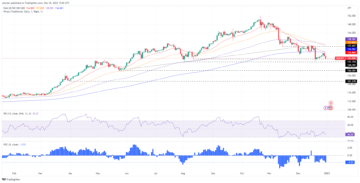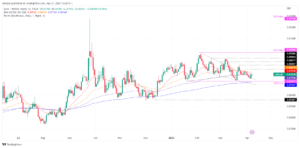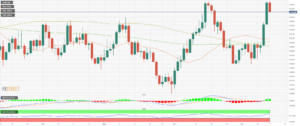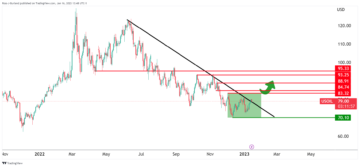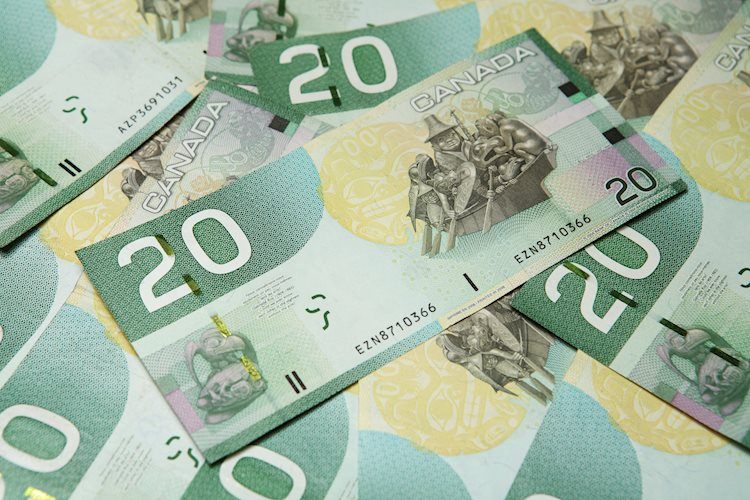
- Canadian Dollar sees gains for holiday Monday as Crude Oil catches a bid on Israeli-Hamas conflict concerns.
- Canada markets are dark for Canadian Thanksgiving, in conjunction with the US Columbus Day holiday.
- It’s a quiet week on the economic calendar for the Canadian Loonie, investors to focus on US CPI inflation figures in the back half of the week.
The Canadian Dollar (CAD) is finding some lift on Monday, extending the Loonie’s rebound against the US Dollar (USD). The USD/CAD is trading back into familiar territory after tapping into a seven-month high last week on broad-market risk aversion flows that sent investors piling into the safe haven Greenback.
Canada is taking Monday off for the Thanksgiving national holiday, but geopolitical tensions around the Gaza Strip have sent global markets into an alert state. Crude Oil prices have lept higher on Middle East stability concerns, helping to prop up the oil-backed Loonie.
Daily Digest Market Movers: Canadian Dollar extends gains against the Greenback on Crude boost
- A rocket attack by Hamas claimed over 700 lives in the Gaza Strip over the weekend, prompting Israel to deploy approximately 100,000 additional troops in the region and igniting market concerns about Crude Oil supply destabilization in the Middle East.
- Oil barrel prices spiked on Monday, with West Texas Intermediary (WTI) Crude Oil up over 4% for the day to trade near $86 a barrel.
- The Canadian Dollar is getting pulled upwards (USD/CAD lower) by lifting barrel costs, extending the Loonie’s rebound from last week’s USD/CAD seven-month peak of 1.3785.
- The US Dollar is down around 0.33% against the CAD for Monday.
- The economic calendar is notably thin on the Canadian data side, leaving market flows to focus predominantly on geopolitical issues, as well as inbound US inflation figures due in the latter half of the trading week.
- US Producer Price Index (PPI) and Consumer Price Index (CPI) figures are due on Wednesday and Thursday, respectively.
- The Canadian exchanges are closed for the Canadian Thanksgiving holiday celebrations, further reactions could be expected when Loonie-based markets reopen on Tuesday.
Technical Analysis: Canadian Dollar extends rebound against US Dollar, trading into 1.3580
The USD/CAD is sliding back below the 1.3600 level after clipping a seven-month high of 1.3785 last week and is down 1.45% from that level.
The pair opened the new trading week near 1.3660, only managing to eke out a minor climb to a daily high of 1.3676 before falling back down the charts to trade into the 200-hour Simple Moving Average (SMA) near 1.3630.
The 200-day SMA is holding flat just above 1.3450, and a continued decline in the USD/CAD will see bids set to make a run at the 50-day SMA, which has confirmed a bullish cross of the longer moving average and is rising into the 1.3550 region.
Canadian Dollar FAQs
The key factors driving the Canadian Dollar (CAD) are the level of interest rates set by the Bank of Canada (BoC), the price of Oil, Canada’s largest export, the health of its economy, inflation and the Trade Balance, which is the difference between the value of Canada’s exports versus its imports. Other factors include market sentiment – whether investors are taking on more risky assets (risk-on) or seeking safe-havens (risk-off) – with risk-on being CAD-positive. As its largest trading partner, the health of the US economy is also a key factor influencing the Canadian Dollar.
The Bank of Canada (BoC) has a significant influence on the Canadian Dollar by setting the level of interest rates that banks can lend to one another. This influences the level of interest rates for everyone. The main goal of the BoC is to maintain inflation at 1-3% by adjusting interest rates up or down. Relatively higher interest rates tend to be positive for the CAD. The Bank of Canada can also use quantitative easing and tightening to influence credit conditions, with the former CAD-negative and the latter CAD-positive.
The price of Oil is a key factor impacting the value of the Canadian Dollar. Petroleum is Canada’s biggest export, so Oil price tends to have an immediate impact on the CAD value. Generally, if Oil price rises CAD also goes up, as aggregate demand for the currency increases. The opposite is the case if the price of Oil falls. Higher Oil prices also tend to result in a greater likelihood of a positive Trade Balance, which is also supportive of the CAD.
While inflation had always traditionally been thought of as a negative factor for a currency since it lowers the value of money, the opposite has actually been the case in modern times with the relaxation of cross-border capital controls. Higher inflation tends to lead central banks to put up interest rates which attracts more capital inflows from global investors seeking a lucrative place to keep their money. This increases demand for the local currency, which in Canada’s case is the Canadian Dollar.
Macroeconomic data releases gauge the health of the economy and can have an impact on the Canadian Dollar. Indicators such as GDP, Manufacturing and Services PMIs, employment, and consumer sentiment surveys can all influence the direction of the CAD. A strong economy is good for the Canadian Dollar. Not only does it attract more foreign investment but it may encourage the Bank of Canada to put up interest rates, leading to a stronger currency. If economic data is weak, however, the CAD is likely to fall.
- SEO Powered Content & PR Distribution. Get Amplified Today.
- PlatoData.Network Vertical Generative Ai. Empower Yourself. Access Here.
- PlatoAiStream. Web3 Intelligence. Knowledge Amplified. Access Here.
- PlatoESG. Carbon, CleanTech, Energy, Environment, Solar, Waste Management. Access Here.
- PlatoHealth. Biotech and Clinical Trials Intelligence. Access Here.
- Source: https://www.fxstreet.com/news/canadian-dollar-extends-rebound-on-gaza-tensions-fueled-crude-oil-bounce-202310091638
- :has
- :is
- :not
- $UP
- 000
- 1
- 100
- 31
- 32
- 36
- 700
- a
- About
- above
- actually
- Additional
- adjusting
- After
- against
- aggregate
- Alert
- All
- also
- always
- an
- analysis
- and
- Animate
- Another
- approximately
- ARE
- around
- AS
- Assets
- At
- attack
- attract
- Attracts
- average
- back
- Balance
- Bank
- bank of canada
- Banks
- BE
- been
- before
- being
- below
- between
- bid
- Biggest
- BoC
- Bullish
- but
- by
- CAD
- Calendar
- CAN
- Canada
- Canadian
- Canadian Dollar
- capital
- capital controls
- case
- celebrations
- central
- Central Banks
- Charts
- claimed
- climb
- closed
- Concerns
- conditions
- CONFIRMED
- conflict
- conjunction
- consumer
- consumer price index
- consumer sentiment
- content
- continued
- controls
- Costs
- could
- CPI
- credit
- Cross
- cross-border
- crude
- Crude oil
- Currency
- daily
- Dark
- data
- day
- Decline
- Demand
- deploy
- destabilization
- difference
- Digest
- direction
- does
- Dollar
- down
- driving
- due
- easing
- East
- Economic
- economy
- employment
- encourage
- ends
- escalation
- everyone
- Exchanges
- expanded
- expected
- export
- exports
- extending
- extends
- factor
- factors
- Fall
- Falling
- Falls
- familiar
- FAQ
- Figures
- finding
- flat
- flow
- Flows
- Focus
- For
- foreign
- foreign investment
- Former
- from
- further
- Gains
- gauge
- GDP
- generally
- geopolitical
- getting
- Global
- global markets
- goal
- Goes
- good
- greater
- Greenback
- had
- Half
- Have
- haven
- Health
- helping
- High
- higher
- holding
- Holiday
- However
- HTTPS
- if
- igniting
- immediate
- Impact
- impacting
- imports
- in
- include
- Increases
- index
- Indicators
- inflation
- inflation figures
- inflows
- influence
- influencing
- interest
- Interest Rates
- intermediary
- into
- investment
- Investors
- Israel
- issues
- IT
- ITS
- jpg
- just
- Keep
- Key
- key factor
- largest
- Last
- lead
- leading
- leaving
- LEND
- Level
- lifting
- likelihood
- likely
- Lives
- local
- longer
- lower
- lucrative
- Main
- maintain
- make
- managing
- manufacturing
- Market
- market sentiment
- Markets
- May..
- Middle
- Middle East
- minor
- Modern
- module
- Monday
- money
- more
- Movers
- moving
- moving average
- National
- Near
- negative
- New
- notably
- of
- off
- Oil
- oil price
- on
- ONE
- only
- opened
- opposite
- or
- Other
- out
- over
- pair
- partner
- Peak
- Petroleum
- Place
- plato
- Plato Data Intelligence
- PlatoData
- positive
- ppi
- predominantly
- price
- Prices
- producer
- pushed
- put
- quantitative
- Quantitative Easing
- Rates
- reactions
- rebound
- region
- relatively
- relaxation
- Releases
- reopen
- respectively
- result
- Rises
- rising
- Risky
- rocket
- Run
- safe
- Safe Haven
- see
- seeking
- sees
- sent
- sentiment
- Services
- set
- setting
- side
- significant
- Simple
- since
- sliding
- SMA
- So
- some
- Stability
- starts
- State
- Strip
- strong
- stronger
- such
- supply
- supportive
- taking
- tapping
- tends
- tensions
- territory
- texas
- Thanksgiving
- that
- The
- their
- this
- thought
- thursday
- tightening
- times
- to
- trade
- Trading
- traditionally
- Tuesday
- Upside
- upwards
- us
- US CPI
- US Dollar
- US economy
- us inflation
- USD
- USD/CAD
- use
- value
- Versus
- Wednesday
- week
- weekend
- WELL
- West
- when
- whether
- which
- will
- with
- WTI
- zephyrnet

